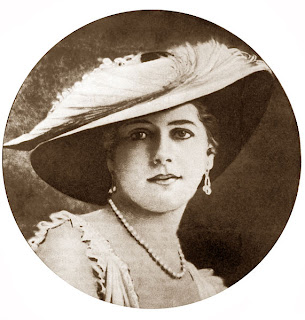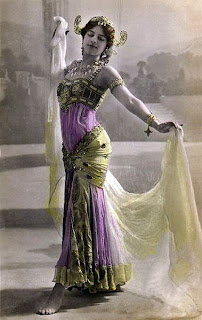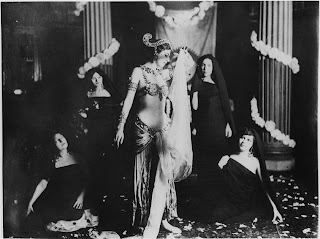Spies
MY NAME IS HARI. MATA HARI.
The life and times of one of the world’s most famous female spies
by Colin Falconer
Just before dawn on October 15, 1917, a woman was woken by a deputation of religious and turnkeys in the Saint-Lazare prison,
just outside Paris. She was driven to the Vincennes Barracks where a twelve man
firing squad awaited her.
A few moments later Mata Hari was dead.
It was the end of
the line for possibly one of the most famous female spies in history.
Mata Hari was
born Gertrud Margarete Zelle. In a society
best known for blonde, blue-eyed women, little M'greet stood apart, with her
thick black hair, black eyes, and olive complexion. She claimed distant
Javanese blood.
Her father was a
successful businessman and M’greet enjoyed a lavish early childhood. But when
she was 13 he went bankrupt. Her parents divorced and when her mother died soon
afterwards she was left in dire straits.
 |
| her husband, Rudolf and son, Norman |
At 18, she married a Dutch Colonial Army Captain, twenty years her senior, who
went by the unusual name of Rudolf MacLeod. He was posted to Java and there she
bore him two children, Jeanne and Norman-John. But Rudolf was a drinker and a womanizer and the
marriage was unhappy.
Then in 1899, both children fell violently ill in
mysterious circumstances. It was claimed they had been poisoned by an irate
servant though other versions say it was the result of their treatment for syphilis
contracted from their parents - almost certainly Rudolph. Jeanne survived, but Norman died.
The family returned to Holland where M’greet sought a divorce - a scandalous move
for a woman in those days. Rudolf reacted bitterly, putting an advertisement in the
Amsterdam newspapers: "I request all and sundry not to supply goods or
services to my estranged wife Margaretha MacLeod-Zelle."
For a while she sought refuge with various relatives and became a sad
charity case. She had no marketable skills, no husband, no job, and
no income.
It was in 1905 that she re-invented herself as Mata Hari, (it’s Javanese for
Eye of the Dawn), posing as a Javanese princess, immersed in the art of sacred
Indian dance. After her debut at the Oriental Studies Museum in 1905 she
achieved overnight fame. Think Lady Gaga and Marilyn Monroe.
The most celebrated segment of her act was her progressive shedding of
clothing until she wore just a spangled bra and some jewellery. (She was seldom
seen without a bra as she was self-conscious about her small breasts). ‘My
dance is a sacred poem,’ she told her audiences.
Her sacred, naked poems became outrageously popular with ecstatic audiences
throughout Europe, because what she had done was invent the modern form of striptease.
Naturally, she attracted the attentions of a number of powerful men; high-ranking military
officers, politicians, and aristocrats. These liaisons frequently took her across international borders.
During World War I, she had a passionate May-November romance with a young Russian
pilot who was flying for the French. When he was wounded in 1916 she asked to
visit him at a forward hospital in a neutral zone. French officials at the
Deuxieme Bureau gave her permission - in return for her spying on the Germans.
After all, she had once been the intimate of Germany’s crown prince.
What happened next is unclear. The French later claimed she had already been
recruited by the Germans under the code name H-21 and she was arrested on her
return to Paris in January 1917.
It is interesting to note that French allegations were based on
intercepted messages passed in a code that the Germans knew had been broken.
Germany's motive may have been to lure France into killing one of their own or because
she was truly a double agent.
But it is also suspicious that the French prosecutor asked to hold the trial
"in camera" (in secret) and to seal the records "for the good of
national security." The motion was granted and the huge crowd who had shown up
for the proceedings were shooed out of the courtroom.
 |
| her scrapbook from Fries Museum, Leeuwarden |
Under the military trial rules of the time, the defence could not
cross-examine the prosecution's witnesses or even question its own. So the guilty
verdict was a foregone conclusion.
Her execution by the French may have been a serious miscarriage of
justice. Perhaps she was no double agent at all.
Yet she remains one of the most famous spies in history, because of
her stage act. Just the idea of an exotic dancer using her
powers of seduction to extract military secrets from her many lovers fired the
popular imagination. The 1931
film starring Greta Garbo was pure fiction; her name has endured not because
she was such a great spy, but because men liked spying on her.
 |
| the execution of Mata Hari from a 1921 film |
Even after her death, her mystery endured. After a threat by the French government to close
the Museum of Anatomy in Paris in 2000, it was discovered her head had
disappeared from a collection of mummified heads of victims of the firing
squad and guillotine.
The court file cannot be opened before the 15 October 2017, exactly one
hundred years after her execution. This might finally shed some light on the actual
truth.
Until then we can only guess whether Hari, Mata Hari, should be remembered
as The Spy Who Loved Me or The Stripper Who Loved Everyone.
Or perhaps the truth is even more poignant; having dragged herself
single-handed from abandonment and destitution, here was a remarkable woman who
achieved fame and fortune on her own terms, and justifiably felt she no longer owed any
loyalty to anyone.
They say that at the end she refused a blindfold and blew a kiss to the
twelve man firing squad: it seems she ended her days as she lived them -from Java, with
Love.
See Colin Falconer's latest novel, Anastasia, here,
and more history from Colin Falconer at
 |
| From History and Women |
























Post a Comment
0 Comments